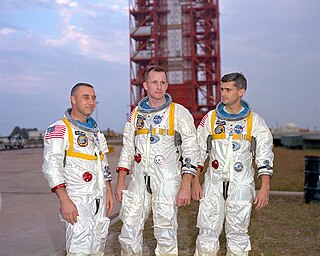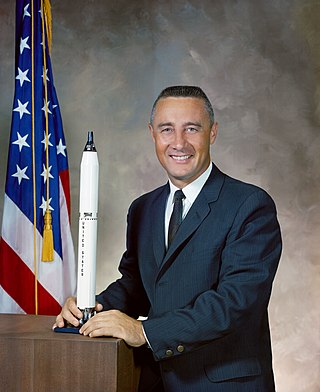The Apollo 1 Hills are three hills on Mars named to memorialize the crew of Apollo 1. The three hills were some of the first landmarks sighted following the January 7, 2004, landing of the Spirit rover on Mars.
The Apollo 1 Hills are three hills on Mars named to memorialize the crew of Apollo 1. The three hills were some of the first landmarks sighted following the January 7, 2004, landing of the Spirit rover on Mars.
NASA astronauts Gus Grissom, Roger Chaffee, and Ed White perished in a flash fire which engulfed their command module on January 27, 1967, while training for the first of the crewed Apollo missions, initially designated as Apollo Saturn-204 (AS-204). [1] [2] Their capsule stood atop the Saturn-1B rocket which was at the time docked to the launchpad gantry at Cape Canaveral's Launch Complex 34, while they performed an in-capsule training for what was to be a low Earth orbit shake-out mission for the United States' Apollo Space Program. [3] The craft was set to launch three weeks later, on February 21, 1967. [1] Following the fire, the mission was renamed Apollo 1 to honor the crew's work. [2] [4]

Mission Command Pilot Grissom had flown in both Mercury and Gemini programs. [2] Chaffee, at 31, was the youngest member of the astronaut corp ever chosen and was prepping for his first flight. [2] White had been the first American to perform a spacewalk during the Gemini program. [2]
The three vastly separated hills are located in the Gusev crater, part of the Aeolis quadrangle on Mars. [1] They were photographed from Spirit's landing site, designated as the Columbia Memorial Station, shortly after the descent and soft landing on the Martian surface of the rover. The Columbia station and the nearby Columbia Hills are themselves named in honor of the seven crew members of the fatal Columbia spacecraft breakup. [1]
The hills are named in memory of the three Apollo 1 astronauts. [2] Grissom Hill is located 7.5 km (4.7 mi) southwest of the Columbia Memorial Station (at Martian co-ordinates 14°34′18″S175°28′43″E / 14.5718°S 175.4785°E ); while 11.2 km (7.0 mi) to the northwest lies White Hill; and Chaffee Hill is located 14.3 km (8.9 mi) south-southwest of the station. [1] As of January 2020, however, the International Astronomical Union has not officially designated the hills with the names of the astronauts.[ citation needed ]
"Through recorded history, explorers have had both the honor and responsibility of naming significant landmarks. Gus, Ed, and Roger's contributions, as much as their sacrifice, helped make our giant leap for mankind possible … as America strides towards our next giant leap, NASA, and the Mars Exploration Rover team created a fitting tribute to these brave explorers and their legacy." – written statement by former NASA Administrator, Sean O'Keefe [1]


The Apollo program, also known as Project Apollo, was the third United States human spaceflight program carried out by the National Aeronautics and Space Administration (NASA), which succeeded in preparing and landing the first humans on the Moon from 1968 to 1972. It was first conceived in 1960 during President Dwight D. Eisenhower's administration as a three-person spacecraft to follow the one-person Project Mercury, which put the first Americans in space. Apollo was later dedicated to President John F. Kennedy's national goal for the 1960s of "landing a man on the Moon and returning him safely to the Earth" in an address to Congress on May 25, 1961. It was the third US human spaceflight program to fly, preceded by the two-person Project Gemini conceived in 1961 to extend spaceflight capability in support of Apollo.

Apollo 9 was the third human spaceflight in NASA's Apollo program. Flown in low Earth orbit, it was the second crewed Apollo mission that the United States launched via a Saturn V rocket, and was the first flight of the full Apollo spacecraft: the command and service module (CSM) with the Lunar Module (LM). The mission was flown to qualify the LM for lunar orbit operations in preparation for the first Moon landing by demonstrating its descent and ascent propulsion systems, showing that its crew could fly it independently, then rendezvous and dock with the CSM again, as would be required for the first crewed lunar landing. Other objectives of the flight included firing the LM descent engine to propel the spacecraft stack as a backup mode, and use of the portable life support system backpack outside the LM cabin.

Apollo 1, initially designated AS-204, was planned to be the first crewed mission of the Apollo program, the American undertaking to land the first man on the Moon. It was planned to launch on February 21, 1967, as the first low Earth orbital test of the Apollo command and service module. The mission never flew; a cabin fire during a launch rehearsal test at Cape Kennedy Air Force Station Launch Complex 34 on January 27 killed all three crew members—Command Pilot Gus Grissom, Senior Pilot Ed White, and Pilot Roger B. Chaffee—and destroyed the command module (CM). The name Apollo 1, chosen by the crew, was made official by NASA in their honor after the fire.

Virgil Ivan "Gus" Grissom was an American engineer, pilot in the United States Air Force, and member of the Mercury Seven selected by National Aeronautics and Space Administration's (NASA) as Project Mercury astronauts to be the first Americans in outer space. He was a Project Gemini and an Apollo program astronaut. As a member of the NASA Astronaut Corps, Grissom was the second American to fly in space in 1961. He was the first man to return to space and was also the second American to fly in space twice, preceded only by Joe Walker with his sub-orbital X-15 flights.

Edward Higgins White II was an American aeronautical engineer, United States Air Force officer, test pilot, and NASA astronaut. He was a member of the crews of Gemini 4 and Apollo 1.

Roger Bruce Chaffee was an American naval officer, aviator and aeronautical engineer who was a NASA astronaut in the Apollo program.

Gemini 3 was the first crewed mission in NASA's Project Gemini and was the first time two American astronauts flew together into space. On March 23, 1965, astronauts Gus Grissom and John Young flew three low Earth orbits in their spacecraft, which they nicknamed Molly Brown. It was the first U.S. mission in which the crew fired thrusters to change the size and shape of their orbit, a key test of spacecraft maneuverability vital for planned flights to the Moon. It was also the final crewed flight controlled from Cape Kennedy Air Force Station in Florida, before mission control functions were moved to a new control center at the newly opened Manned Spacecraft Center in Houston, Texas.

John Watts Young was an American astronaut, naval officer and aviator, test pilot, and aeronautical engineer. He became the 9th person to walk on the Moon as commander of the Apollo 16 mission in 1972. He is the only astronaut to fly on four different classes of spacecraft: Gemini, the Apollo command and service module, the Apollo Lunar Module and the Space Shuttle.

Project Gemini was NASA's second human spaceflight program. Conducted between projects Mercury and Apollo, Gemini started in 1961 and concluded in 1966. The Gemini spacecraft carried a two-astronaut crew. Ten Gemini crews and 16 individual astronauts flew low Earth orbit (LEO) missions during 1965 and 1966.

The Space Mirror Memorial, which forms part of the larger Astronauts Memorial, is a National Memorial on the grounds of the John F. Kennedy Space Center Visitor Complex on Merritt Island, Florida. It is maintained by the Astronauts Memorial Foundation (AMF), whose offices are located in the NASA Center for Space Education next door to the Visitor Complex. The memorial was designed in 1987 by Holt Hinshaw Pfau Jones, and dedicated on May 9, 1991, to remember the lives of the men and women who have died in the various space programs of the United States, particularly those of NASA. The Astronauts Memorial has been designated by the U.S. Congress "as the national memorial to astronauts who die in the line of duty".

The Kennedy Space Center Visitor Complex is the visitor center at NASA's Kennedy Space Center on Merritt Island, Florida. It features exhibits and displays, historic spacecraft and memorabilia, shows, two IMAX theaters, and a range of bus tours of the spaceport. The "Space Shuttle Atlantis" exhibit contains the Atlantis orbiter and the Shuttle Launch Experience, a simulated ride into space. The center also provides astronaut training experiences, including a multi-axial chair and Mars Base simulator. The visitor complex also has daily presentations from a veteran NASA astronaut. A bus tour, included with admission, encompasses the separate Apollo/Saturn V Center. There were 1.7 million visitors to the visitor complex in 2016.
Several planned missions of the Apollo crewed Moon landing program of the 1960s and 1970s were canceled, for reasons which included changes in technical direction, the Apollo 1 fire, hardware delays, and budget limitations. After the landing by Apollo 12, Apollo 20, which would have been the final crewed mission to the Moon, was canceled to allow Skylab to launch as a "dry workshop". The next two missions, Apollos 18 and 19, were later canceled after the Apollo 13 incident and further budget cuts. Two Skylab missions also ended up being canceled. Two complete Saturn V rockets remained unused and were put on display in the United States.

Launch Complex 34 (LC-34) is a deactivated launch site on Cape Canaveral Space Force Station, Florida. LC-34 and its companion LC-37 to the north were used by NASA from 1961 through 1968 to launch Saturn I and IB rockets as part of the Apollo program. It was the site of the Apollo 1 fire, which claimed the lives of astronauts Gus Grissom, Ed White, and Roger Chaffee on January 27, 1967. The first crewed Apollo launch — Apollo 7 on October 11, 1968 — was the last time LC-34 was used.

Space Center Houston is a science museum that serves as the official visitor center of NASA Johnson Space Center in Houston. It was designated a Smithsonian Affiliate museum in 2014. The organization is owned by NASA, and operated under a contract by the nonprofit Manned Spaceflight Education Foundation, a 501(c)(3) organization. The Johnson Space Center is the home of Mission Control and astronaut training.

The following outline is provided as an overview of and topical guide to space exploration.

John P. Healey was an American aerospace executive manager. He was best known for his role in the redesign and manufacture of the command modules for the Apollo program after the catastrophic launch pad fire that took the lives of Command Pilot Virgil I. "Gus" Grissom, Senior Pilot Ed White and Pilot Roger B. Chaffee on January 27, 1967. He died in March 2019 at the age of 97.
Advanced Gemini is a number of proposals that would have extended the Gemini program by the addition of various missions, including crewed low Earth orbit, circumlunar and lunar landing missions. Gemini was the second crewed spaceflight program operated by NASA, and consisted of a two-seat spacecraft capable of maneuvering in orbit, docking with uncrewed spacecraft such as Agena Target Vehicles, and allowing the crew to perform tethered extra-vehicular activities.